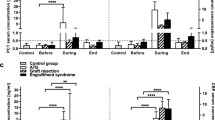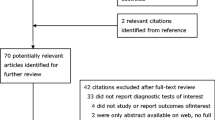Abstract
Background
Procalcitonin (PCT) is considered a sensitive and specific diagnostic and prognostic marker of systemic bacterial infection, but its value is questionable in certain clinical conditions, particularly in hemato-oncological patients.
Materials and methods
We analyzed PCT and C-reactive protein (CRP) levels in 56 patients of a pediatric hematology–oncology unit during 110 consecutive non-infectious febrile episodes related to administration of T-cell antibodies (group A; n = 22), alemtuzumab (monoclonal CD52 antibody, CAMPATH-1H/group B; n = 8), interleukin-2 (IL-2/group C; n = 41), prophylactic donor granulocyte transfusions (group D; n = 9), or to acute graft-versus-host disease (aGvHD/group E; n = 10) and compared the results with 20 episodes of Gram-negative sepsis (group F).
Main results
In the majority of the non-infectious episodes PCT and CRP increased to serum levels statistically indistinguishable from Gram-negative sepsis. Median peak levels of PCT (normal < 0.5 ng/ml)/CRP (normal < 8 mg/l) for groups A–F were 4.34/59.0 (A), 10.14/93.5 (B), 1.11/175.0 (C), 1.43/164 (D), 0.96/34.0 (E), and 8.14 ng/ml /126.0 mg/l (F). Highest single levels were observed in groups A and F.
Conclusions
PCT and CRP are of limited value as diagnostic markers of sepsis during T-cell-directed immunomodulatory treatment, granulocyte support, or acute GvHD.
Similar content being viewed by others
References
Aouifi A, Piriou V, Bastien O, Blanc P, Bouvier H, Evans R, Celard M, Vandenesch F, Rousson R, Lehot JJ (2000) Usefulness of procalcitonin for diagnosis of infection in cardiac surgical patients. Crit Care Med 28(9):3171–3176
Blijlevens NM, Donnelly JP, Meis JF, De Keizer MH, De Pauw BE (2000) Procalcitonin does not discriminate infection from inflammation after allogeneic bone marrow transplantation. Clin Diagn Lab Immunol 7(6):889–892
Christ-Crain M, Jaccard-Stolz D, Bingisser R, Gencay MM, Huber PR, Tamm M, Muller B (2004) Effect of procalcitonin-guided treatment on antibiotic use and outcome in lower respiratory tract infections: cluster-randomised, single-blinded intervention trial. Lancet 363(9409):600–607
Christ-Crain M, Müller B (2005) Procalcitonin in bacterial infections—hype, hope, more or less. Swiss Med Wkly 135:451–460
Dehne MG, Sablotzki A, Hoffmann A, Muhling J, Dietrich FE, Hempelmann G (2002) Alterations of acute phase reaction and cytokine production in patients following severe burn injury. Burns 28(6):535–542
Dornbusch HJ, Kerbl R, Lackner H, Preisegger KH, Schwinger W, Berghold A, Urban C (2000) Procalcitonin and C-reactive protein levels at the time of engraftment after stem cell transplantation. Acta Chir Austriaca 32(Suppl 170):37
Dornbusch HJ, Strenger V, Kerbl R, Lackner H, Schwinger W, Sovinz P, Urban C (2003) Procalcitonin and C-reactive protein do not discriminate between febrile reaction to anti-lymphocyte antibodies and Gram-negative sepsis. Bone Marrow Transplant 32:941–945
Dornbusch HJ, Strenger V, Kerbl R, Lackner H, Schwinger W, Sovinz P, Urban C (2005) Procalcitonin—a marker of invasive fungal infection. Support Care Cancer 13:343–346
Fleischhack G, Kambeck I, Cipic D, Hasan C, Bode U (2000) Procalcitonin in paediatric cancer patients: its diagnostic relevance is superior to that of C-reactive protein, interleukin-6, interleukin-8, soluble interleukin-2 receptor and soluble tumour necrosis factor receptor II. Br J Haematol 111(4):1093–102
Hansson LO, Lindquist L (1997) C-reactive protein: its role in the diagnosis and follow-up of infectious diseases. Curr Opin Infect Dis 10:196–201
Hayden WR (1994) Sepsis terminology in pediatrics. J Pediatr 124(4):657–658
Jimeno A, Garcia-Velasco A, del Val O, Gonzalez-Billalabeitia E, Hernando S, Hernandez R, Sanchez-Munoz A, Lopez-Martin A, Duran I, Robles L, Cortes-Funes H, Paz-Ares L (2004) Assessment of procalcitonin as a diagnostic and prognostic marker in patients with solid tumors and febrile neutropenia. Cancer 100(11):2462–2469
Legouffe E, Rodriguez C, Picot MC, Richard B, Klein B, Rossi JF, Commes T (1998) C-reactive protein serum level is a valuable and simple prognostic marker in non-Hodgkin lymphoma. Leuk Lymphoma 31:351–357
Mousset S, Hermann S, Klein SA, Bialleck H, Duchscherer M, Bomke B, Wassmann B, Boehme A, Hoelzer D, Martin H (2005) Prophylactic and interventional granulocyte transfusions in patients with haematological malignancies and life-threatening infections during neutropenia. Ann Hematol 84(11):734–741 (electronically prepublished 11 Jun 2005)
Müller B, White J, Nylen E, Snider R, Becker K, Habener J (2001) Ubiquitous expression of the calcitonin-1 gene in multiple tissues in response to sepsis. J Clin Endocrinol Metab 86:396–404
Okada Y, Minakami H, Tomomasa T, Kato M, Inoue Y, Kozawa K, Kimura H, Morikawa A (2004) Serum procalcitonin concentration in patients with Kawasaki disease. J Infect 48(2):199–205
Persson L, Soderquist B, Engervall P, Vikerfors T, Hansson LO, Tidefelt U (2005) Assessment of systemic inflammation markers to differentiate a stable from a deteriorating course in patients with febrile neutropenia. Eur J Haematol 74(4):297–303
Pihusch M, Pihusch R, Fraunberger P, Pihusch V, Andreesen R, Kolb HJ, Holler E (2006) Evaluation of C-reactive protein, interleukin-6, and procalcitonin levels in allogeneic hematopoietic stem cell recipients. Eur J Haematol 76(2):93–101
Przepiorka D, Weisdorf D, Martin P, Klingemann HG, Beatty P, Hows J, Thomas ED (1995) 1994 Consensus conference on acute GvHD grading. Bone Marrow Transplant 15(6):825–828
Sabat R, Hoflich C, Docke WD, Oppert M, Kern F, Windrich B, Rosenberger C, Kaden J, Volk HD, Reinke P (2001) Massive elevation of procalcitonin plasma levels in the absence of infection in kidney transplant patients treated with pan-T-cell antibodies. Intensive Care Med 27(6):987–991
Saijo Y, Kiyota N, Kawasaki Y, Miyazaki Y, Kashimura J, Fukuda M, Kishi R (2004) Relationship between C-reactive protein and visceral adipose tissue in healthy Japanese subjects. Diabetes Obes Metab 6(4):249–258
Schwinger W, Klass V, Benesch M, Dornbusch HJ, Sovinz P, Moser A, Schwanzer G, Urban C (2005) Feasibility of high-dose interleukin-2 in heavily pretreated pediatric cancer patients. Ann Oncol 16:1199–1206
Simon L, Gauvin F, Amre DK, Saint-Louis P, Lacroix J (2004) Serum procalcitonin and C-reactive protein levels as markers of bacterial infection: a systematic review and meta-analysis. Clin Infect Dis 39:206–217
Sipsas NV, Bodey GP, Kontoyiannis DP (2005) Perspectives for the management of febrile neutropenic patients with cancer in the 21st century. Cancer 103(6):1103–1113
Toikka P, Irjala K, Juven T, Virkki R, Mertsola J, Leinonen M, Ruuskanen O (2000) Serum procalcitonin, C-reactive protein and interleukin-6 for distinguishing bacterial and viral pneumonia in children. Pediatr Infect Dis J 19(7):598–602
Van Rossum AMC, Wulkan RW, Oudesluys-Murphy AM (2004) Procalcitonin as an early marker of infection in neonates and children. Lancet Infect Dis 4:620–630
Wing MG, Thibault M, Greenwood J, Smith RM, Hale G, Isaacs J, Waldmann H, Lachmann PJ, Compston A (1996) Mechanism of first-dose cytokine-release syndrome by CAMPATH 1-H: involvement of CD16 (FCgammaRIII) and CD11a/CD18 (LFA-1) on NK cells. J Clin Invest 98:2819–2826
Yip HK, Hang CL, Fang CY, Hsieh YK, Yang CH, Hung WC, Wu CJ (2005) Level of high-sensitivity C-reactive protein is predictive of 30-day outcomes in patients with acute myocardial infarction undergoing primary coronary intervention. Chest 127(3):803–808
Acknowledgements
We are indebted to Dr. Petra Ofner and Prof. Andrea Berghold from the Institute for Medical Informatics, Statistics and Documentation for their professional assistance in statistical analysis.
Financial support
None.
Author information
Authors and Affiliations
Corresponding author
Additional information
The data was presented in part at the 42nd Interscience Conference on Antimicrobial Agents and Chemotherapy, San Diego, USA, September 27 to 30, 2002.
Rights and permissions
About this article
Cite this article
Dornbusch, H.J., Strenger, V., Sovinz, P. et al. Non-infectious causes of elevated procalcitonin and C-reactive protein serum levels in pediatric patients with hematologic and oncologic disorders. Support Care Cancer 16, 1035–1040 (2008). https://doi.org/10.1007/s00520-007-0381-1
Received:
Accepted:
Published:
Issue Date:
DOI: https://doi.org/10.1007/s00520-007-0381-1




